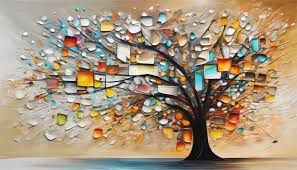
Painting is more than just an art form; it’s a profound expression of human abstracte schilderijen experience and emotion that has evolved dramatically over centuries. From ancient cave walls to modern digital canvases, painting continues to captivate and inspire, bridging cultural divides and speaking to the very core of our humanity.
The Origins of Painting
The history of painting stretches back to the earliest days of human civilization. The oldest known paintings, found in the Chauvet Cave in France, date back over 30,000 years. These prehistoric artworks offer a glimpse into the lives of our ancestors, depicting animals and abstract symbols with remarkable precision. These early paintings were not just decorative; they held spiritual and ritualistic significance, reflecting the complex relationship between early humans and their environment.
Renaissance Revival: The Rebirth of Painting
The Renaissance marked a pivotal moment in the evolution of painting. Artists like Leonardo da Vinci, Michelangelo, and Raphael pushed the boundaries of artistic technique and expression. This period saw the development of perspective, a technique that created the illusion of depth on a flat surface. The Renaissance was characterized by a renewed interest in classical antiquity, resulting in works that celebrated humanism and the potential of the individual.
The Impressionist Revolution
Fast forward to the late 19th century, and the Impressionist movement emerged as a radical departure from traditional artistic conventions. Pioneered by artists such as Claude Monet, Edgar Degas, and Pierre-Auguste Renoir, Impressionism focused on capturing the fleeting effects of light and color. Instead of meticulous detail, Impressionists employed loose brushwork and vibrant palettes to convey the essence of a moment. This movement laid the groundwork for subsequent artistic innovations and challenged conventional views of what art could be.
Abstract Expressionism and Beyond
The 20th century brought a wave of new artistic movements that continued to expand the boundaries of painting. Abstract Expressionism, led by figures like Jackson Pollock and Mark Rothko, emphasized spontaneity and emotional intensity. This movement shifted the focus from representational art to the exploration of color, form, and texture. Following Abstract Expressionism, movements such as Pop Art, with artists like Andy Warhol and Roy Lichtenstein, explored themes of consumerism and popular culture, reflecting the dynamic changes of the contemporary world.
Digital and Mixed Media: The Future of Painting
In the digital age, painting has embraced new technologies and mediums. Digital painting, created using software and tablets, allows artists to experiment with endless possibilities and reach global audiences instantly. Additionally, mixed media approaches combine traditional painting techniques with materials like photography, collage, and sculpture, creating hybrid works that push the boundaries of what painting can be.
The Enduring Power of Painting
Despite the many transformations in its form and approach, painting remains a vital and expressive medium. It provides a unique lens through which we can explore and understand the human condition, cultural heritage, and the ever-changing world around us. Whether through the timeless beauty of a Renaissance masterpiece or the avant-garde experimentation of contemporary works, painting continues to resonate deeply, inviting viewers to connect with their own emotions and experiences.
Painting is not just a visual experience; it is a journey through the human spirit, capturing moments of beauty, struggle, and triumph. As we continue to explore new artistic horizons, the essence of painting remains a testament to our creativity and our quest to make sense of the world around us.
